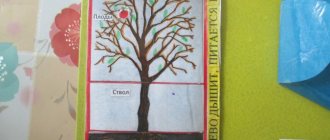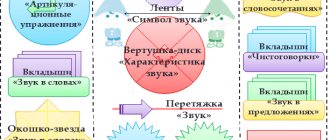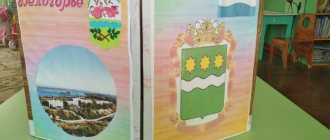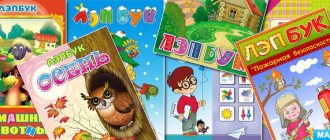Lapbook as an original innovative guide, beautiful and useful
The author of the manual is considered to be American Tammy Dubey. She came up with the idea of filling a small folder with a variety of pictures, pockets, rhymes, and paper crafts to reinforce and preserve the information she had learned with her children. Photos of the first lapbooks found their way onto the Internet and this manual became the property of all concerned parents, educators and teachers. Lapbooking (production of lapbooks) is recognized as an innovative technology with many advantages.
The very name of the manual is translated from English either as a “knee book” or as a “folding book”, and both options are completely fair. Lapbooks are small in size (usually A4 format when folded) and it is convenient for a child to look at them while holding them on his lap. In addition, these wonderful books are full of riddles and secrets, they fold out and have many pockets, inserts, notepads, which in turn open, which is very much to the taste of little researchers and lovers of secrets.
Studying a laptop begins with looking at all the treasures hidden in it.
What game elements are included in the layout and why?
Lapbooks for preschoolers are distinguished by a greater (compared to school) presence of game elements. These are rotating circles, opening windows, moving parts and figures. The first impression of a lapbook is usually for both children and adults: it’s fun, entertaining. But this is how it should be, because preschool children learn about the world through play. The first two or three lessons with a laptop will definitely be devoted to studying its wonderful properties and capabilities as a toy, and only after that the kids will be able to comprehend the useful information contained in it. There is no point in rushing children; their involuntary memory and attention are very developed, and unnoticed by themselves, by manipulating with pockets, circles and pictures, they will learn a fairly extensive amount of information.
It is thanks to such unusual elements that kids really like lapbooks.
Benefits for preschoolers and teachers
Two significant features of the laptop should be noted:
- Interactivity. The child interacts with the folder, rather than just looking at it. Active participation greatly increases interest in the benefit. This is especially important for kinesthetic children (with a predominance of the sense of touch as a means of understanding the world around them), because it is no secret that in the modern educational process visual methods predominate (demonstration of illustrations, videos and slides), as well as the use of music and audio recordings.
- Thematic. It is difficult to collect information on different topics in a small folder; it will be difficult for children to assimilate and understand it, so lapbooks are usually dedicated to one topic, for example, “Autumn”, “Birds”, “Family”. In the older group, which involves a more in-depth study of certain topics, it is possible to cover a more specific subtopic in the lapbook: “Gifts of Autumn”, “Wintering Birds”, “Family Holidays”.
Thus, a modern lapbook is a thematic interactive folder (book) containing systematized and variously designed information.
Usually the title page of a folder already announces its topic.
The purposes for using lapbooks are also very diverse. This includes consolidating everything that children have learned during the project, learning to collect and systematize information, developing creativity and creativity, and fostering a caring attitude towards a product made collectively, and respect for common work. One of the most important objectives of the manual is considered to be the stimulation of cognitive activity in children, the desire to learn and remember new things, and in older preschool age, the awakening of the desire to learn.
Lapbook as a learning tool in the context of the Federal State Educational Standard
This article talks about the use of lapbook technology in English lessons. Based on his experience, the author of the article shows the advantages of this method over others within the framework of the implementation of the new federal state educational standard of the second generation, without forgetting the minor disadvantages of this work.
Key words : lapbook, Federal State Educational Standards, creativity, creativity, individual, pair and group work.
In the context of the implementation of the new federal state educational standard of the second generation (FSES), the teacher has to look for new teaching tools that meet new requirements and learning goals.
An important aspect of modern Russian education is “teaching oneself to learn.” The teacher is faced with the task of teaching the student to set goals and objectives, find ways to solve them, and most importantly, find the necessary information to solve the question posed among a huge variety of sources of information. We all know that we remember better what is interesting to us, what was emotionally charged. How to make sure that the material covered remains in the student’s memory, so that he can learn to use the knowledge that he received in lessons on a certain topic, so that he wants to independently expand his horizons on this issue.
One of the ways to achieve this goal of education at this stage of the development of society, I find, is to use the technique of creating a lapbook in English lessons, which is actively used by American teachers and parents who teach their children at home.
First, let's figure out what the concept of “lapbook” means:
A laptop is a portfolio or a collection of small books with pockets and windows that make it possible to place information in the form of drawings, small texts, diagrams and graphs in any form and on any topic. This is a book that the student assembles himself, glues its individual parts into a single whole, and creatively designs it using all kinds of colors and shapes. Most often, the basis for a lapbook is hard paper or cardboard, the main thing is that the lapbook is sized to fit on the student’s lap. [1]
Thus, we can say that a lapbook is a collective image of a poster, book and handouts, which is aimed at developing the student’s creative potential, which teaches him to think and act creatively within a given topic, expanding not only his horizons, but also developing skills and abilities necessary to overcome difficulties and solve the problem.
One of the advantages of this work is the fact that the work on creating a lapbook can be individual, paired or group. Let's look at each of them separately:
Working individually, one student searches, collects information and designs his work independently, relying only on himself and his own strengths. This type of work is necessary if there are students in a group or class who find it difficult to find contact with other classmates, if they are shy and unsociable. It helps such students discover themselves and their potential in front of the teacher and peers.
On the other hand, when working in pairs, students have to share responsibility among themselves. They learn to divide the task into micro-topics and work on their topic individually or do all the work together.
From the point of view of a child’s socialization in society, an important form of work is interaction in a small group, when 3–5 students work on one laptop. Here, on the one hand, everyone must understand their importance, and on the other hand, it should not be allowed that someone is left without a specific task, thinking that someone else will do all the work for him. In a group, schoolchildren learn to build their working relationships not on personal likes and dislikes for each other, but on the desire to do the job as well as possible, especially since the work on creating a lapbook (from its design to its implementation) is labor-intensive both in time and by content.
Work on a lapbook is quite diverse, in addition, the role of the teacher in such work is not to be a source of information, but quite the contrary, the teacher is the factor that pushes students to make discoveries, albeit insignificant at first glance. The teacher is an outside observer who only if necessary intervenes in the process of creating a lapbook and helps with advice when necessary.
Each lapbook is unique, as is its creator, there is no right or wrong method for creating it, because it all depends on how the student perceives a given topic, what means he uses to achieve his goals. [1] Anything is suitable for working on a laptop: colored paper; both cut out and self-drawn pictures; handwritten or printed texts, graphs and diagrams.
Another benefit of a lapbook is the fact that a lapbook is an amazing handmade educational tool. The lapbook itself is very interactive, from the process of its creation to the finished result. And each component of the lapbook that a student works on gives him the opportunity to focus his attention on a specific aspect of a larger topic. [2]
In addition to educational advantages, a lapbook can be perceived by students as a “treasure” to which it is interesting to return, leaf through and revise information, remembering it and accumulating it in their memory. Working, it would seem, on the same topic, children from different pairs and groups very often find solutions to the problems posed to them in different ways - this is surprising, but it is precisely at such moments that the teacher realizes that he is standing on one of the steps of the ladder leading to The main goal of modern education is to teach oneself to learn.
Therefore, when the created “treasure” is shown to classmates, spontaneous discussions and debates occur, which contribute to improving the assimilation of information. If we are talking about the subject “English,” then students develop not only their passive vocabulary when searching for information, but also their active one, because in defending their point of view, they use the material that they found and displayed in a laptop.
It should be noted that while working on one laptop, students often discover topics for their next research. After all, the more often children are faced with the need to learn something new, the more often the unexplored and incomprehensible attracts their attention.
As mentioned above, a lapbook is a specific aspect of a more global topic, therefore, with the correct structure of the work, a teacher, during the period of teaching his subject, can create with a class or group a whole series of lapbooks on one topic, which will more fully reflect the problems associated with this topic. For example, already at the initial stage of training, sections related to food appear. Thus, you can create lapbooks of different content and design that will tell about different aspects of nutrition and everything connected with it. Key questions may include “In a cafe”, “Cuisines of the world”, “Diet”, “Vegetarianism” and much more.
The content and development of these questions and topics will depend on the students, on how they see the problem and on how they want to solve it. As a result, by the end of the training, each student will have his own portfolio, which is interesting to work with, which is easy to use, and most importantly, it will contain the necessary information on various problems of the reality around us.
The fact that solving a problem and filling a lapbook with information depends on the student suggests that when creating a lapbook, individual and differentiated approaches to learning are provided. Evaluating each work also requires an individual approach to each student, since for a student with average academic performance, it is sometimes simply impossible to individually create a work of this order (research, with conclusions, with cause-and-effect relationships). However, while working on a lapbook, he can prove himself and surpass his classmate, whose academic performance is an order of magnitude higher.
It should be noted that the use of lapbooks in the classroom and in extracurricular activities is not possible in every type of educational session for a number of reasons. This teaching method and technique is suitable for a consolidation lesson or a generalization and repetition lesson, when students have a certain degree of knowledge on a given topic, but when creating a lapbook, they have to detail information on the central topic of the lapbook, take a creative approach to the design and explanation of both what has already been studied and and new material.
One of the disadvantages of this work is the time required to create a laptop. One lesson or an outside lesson will not be enough, especially considering the fact that before creating the final product, you need to carefully consider its structure and find the necessary information.
Most of the work (planning and searching for information) can be done at home, but in consultation with the teacher. The final creation of a lapbook must be carried out as part of a lesson, so that the work of each group member or student individually can be seen, so that classmates have the opportunity to share their discoveries with each other.
Also, the teacher, as a senior mentor and assistant, requires additional preparation for the upcoming lesson, because the students will have questions, they will have information that he may not know and you need to be prepared for this, you need to have a correct attitude to the situation when the student knows something that the teacher does not know. In this situation, the teacher must clearly remember and explain to his students that the teacher, within the framework of modern education, is primarily not a source of knowledge, but an experienced guide to the search, perception and assimilation of knowledge.
To summarize, it should be noted that, despite the minor disadvantages that working on a laptop has, its advantages are undeniable. Creating a lapbook solves a number of problems of modern education, giving students not only knowledge of the subject, but also teaching them to look at a problem comprehensively, pose problems and solve them, and take a creative approach to organizing and selecting information.
In the context of modernization of education, a teacher needs to look for new teaching methods and technologies that would help him teach and educate the personality that a new modern society needs - a personality who can think outside the box, propose and implement various ideas. By using the technique of creating a lapbook in your work, you will have the opportunity to prepare just such a person for a new life in new conditions.
A laptop is not just a method that helps consolidate and practice acquired knowledge in the classroom, it is a flight of fancy that can give unpredictable results, it is research that, once started, will continue throughout life, because if you sow the “seed” of discovery and research in a child, it will grow and increase. The teacher’s task is only to give students confidence in their abilities and properly motivate them to open new horizons.
Literature:
1. https://lapbooking.wordpress.com/lapbook/
2. https://www.rosettastone.com/homeschool/articles/what-is-lapbooking
Types of lapbooks
Thematic folders come in several types. They are mainly distinguished by the method of application.
Types of benefits depending on purpose and content
It is customary to distinguish the following types of laptops according to their purpose:
- Gaming . This folder is intended for play, together with a teacher or for an independent child, so the main emphasis in it must be on entertainment and ease of perception of information. In addition to movable game elements (windows, circles, sliding pockets-petals), you can put into it the now popular walking games, cards for logic games like “Who am I?”, “What did I wish for?”, small items for the game “What” in my hand?”, “Guess by touch” in a small fabric bag.
- Educational (encyclopedic) . An excellent tool for organized educational activities and individual work to consolidate a specific topic. In such a lapbook you can place not only educational games, memory cards, proverbs, but also interesting facts, folk signs, and quiz questions. Naturally, children will be able to use such a benefit with the help of a teacher.
- Congratulatory . It will be an original and very pleasant gift for a loved one whose tastes and hobbies you know well. A daughter’s best friend would like a lapbook made together with her mother, in which there is room for shared photographs of the girlfriends, a paper doll with a set of dresses and accessories, a hand-sewn rag doll, and a small flat box with children’s jewelry. A lapbook as a gift for a boy can be filled with magnets with images of dinosaurs, cartoon characters, a wooden construction set (its parts are flat and will fit in an envelope), photographs of your favorite athletes, cars.
- Autobiographical . This can be either the story of one child (the parents help the child make the materials and design at home), or the life story of one kindergarten group, which will contain photos, crafts and funny sayings of the kids. When making the “Our Group” lapbook, it is important to distribute the material so that each child receives attention, each is present in some section and in at least one of the photographs.
This New Year's lapbook will be a wonderful gift for the whole family.
Differences in lapbooks depending on the age of children
Equally important is the division of lapbooks according to the age of the children. Thematic folders for primary preschool age are distinguished by a smaller number of pages, interactive elements, more general coverage of information, and large details.
Experts who use lapbooks in depth recommend their use in working with children aged five years and older, but even at a younger age, under the supervision of a teacher, children can work with a lapbook and learn how to put things in order (fold pictures into envelopes, fold and close petals “secrets”, etc.). Folders for the development of color perception in combination with tactile perception (with elements made of multi-colored felt, fabric, fur, burlap) will be useful at this age.
A laptop for little ones has large elements and a minimum of tasks.
For fidgety four-year-olds of the middle group, folders with a large number of moving elements, puzzles, and simple logic problems (“Find a pair,” “What’s extra?”) are suitable. This simultaneously helps to develop children and satisfy their natural curiosity at this age.
Children of the middle group will enthusiastically consolidate their knowledge about fruits and vegetables by placing pictures in the right baskets
Older preschoolers show not only interest in the entertainment possibilities of a lapbook, but also inquisitiveness and consistency in mastering the knowledge contained in it. They are interested in both looking at the image and learning new information about it. Therefore, in pictures in folders, you can place short texts with educational information on the back. Children often ask the teacher to read them, memorize them and retell them to their friends.
The development of thinking and improved memory of children of the sixth or seventh year of life justifies the complication of the material presented. Older preschoolers have access to the games “Remember the Proverb”, “Read the Poem”, “Words-Relatives”, in which it is necessary to reproduce a certain text from a picture. Children of this age are also interested in logical games “What comes first, what comes next”, “Put the pictures in order”, “Part and whole”, “Opposites”. They are placed in a laptop, selecting images in accordance with the theme.
The folder for older preschool age contains much more text information and related tasks
Materials and shape of the interactive folder
The material from which lapbooks are made can be very diverse, the main thing is that it is approved for use in preschool institutions. For this reason, it is better not to use some types of building materials (ceiling tiles, finishing plastic), because inexpensive types of them may be of poor quality, and those that meet the standards “bite” in price. Therefore, it is better to focus on familiar, safe materials: cardboard, whatman paper, colored paper. Cardboard boxes for sweets, cookies, ready-made A4 folders, folders for manual labor, where additional sheets are glued, are also suitable for the base.
The shapes of lapbooks depend on the imagination of their creators:
- Classic rectangular;
- Square, oval, in the form of other geometric shapes;
- Reflecting the theme of the folder, that is, in the form of a nesting doll, a cup, a bird, a flower, a cloud.
When choosing a shaped option, you should remember that the lapbook will be used often, and too small, thin parts, for example, the spout of a teapot or the stem of a flower, may simply fall off.
Recently, a “lapbox” manual has appeared, that is, a “folding box”. It is distinguished by its design, in which parts of the product are folded into a box and secured with tape or fasteners. When the fastening is removed, the laptop “disintegrates”, revealing the contents of the walls, that is, the same envelopes, notebooks, and other elements. This impressive manual is suitable for games and gifts, but is still little used as a teaching tool.
Video: playing with lapbox in a kindergarten group
Lapbooks in the form of books with a small number of pages, folders with inserts and accordion screens have taken root in kindergartens. It is difficult for children to hold the latter on their laps; they are used on a table or rug.
Photo gallery: types of lapbooks used by kindergarten teachers
A traditional version of a lapbook from a ready-made stationery folder with inserts
This lapbook will help young mathematicians navigate the world of numbers and figures.
An original version of a lapbook with knitted elements from handicraft educators
You can't do without letters in a literacy lapbook
A butterfly-shaped folder will teach kids about these wonderful insects.
An ecology laptop will teach kids how to sort garbage
The interactive folder about the ladybug looks elegant and is filled with interesting tasks
"Lapbook" as an innovative approach to working with preschool children
"Lapbook" as an innovative approach to working with preschool children
Author: Tarakanova Lyudmila Nikolaevna
Organization: MBDOU Kindergarten No. 184
The main feature of the organization of educational activities in preschool educational institutions at the present stage is the departure from educational activities (classes), increasing the status of games as the main activity of preschool
;
inclusion in the process of effective forms of work with children
: ICT, project activities, gaming, problem-based learning situations as part of the integration of educational areas.
Thus, “class” as a specially organized form of educational activity in kindergarten is abolished. The activity should be a specific children's activity that is interesting for children, specially organized by the teacher, implying their activity, business interaction and communication, accumulation by children
certain information about the world around us, the formation of certain knowledge, skills and abilities.
But at the same time, the learning process remains. Teachers continue to “work” with children
. Meanwhile, it is necessary to understand the difference between “old” learning and “new” learning.
In our practice, we increasingly encounter children who do not want to study, who are not interested in what is happening in the joint educational activities of the teacher and children. Therefore, an important condition for increasing the effectiveness of work with preschool children is
are not the expansion of educational tasks, but
the development of
new pedagogical technologies, related, first of all, to the specifics of a child’s communication with adults and peers with the rational effective organization of a child’s life in kindergarten, aimed at developing the child’s independent activity and personality development.
In order to meet modern requirements in the context of the implementation of the Federal State Educational Standard, every teacher is looking for new tools and methods in their work. To do this, you need to constantly study, engage in self-education, and improve your professional level. The result of such a search in my case was “ lapbook
».
A lapbook, or as it is also called a thematic folder, is a relatively new learning tool that came from America. The term “lapbook” was first coined by Virginia (USA) mother and writer Tammy Dubey, who used this tool to organize information in her children’s homeschooling.
«Lapbook
“This is not just a folder - it’s a homemade interactive folder with pockets, doors, windows, moving parts that a child can take out, rearrange, fold at his own discretion.
It collects material on a specific topic. This is a visual and practical teaching method, the final stage of independent research work
that the child has done while studying this topic. To fill out this folder, the child will need to complete certain tasks, make observations, and study the material presented.
Stages of making a “knee book” (step by step)
If a lapbook is the final stage of a project activity, then it is made simply: take a capacious folder, collect all the materials accumulated during the project (drawings, task cards, children’s flat products) and place them in appropriately sized pockets. Next, children can use the folder to remember their participation in the project and discuss their impressions of it.
But making a laptop can also become a separate project, in which case careful and painstaking preparation is required. It consists of the following points:
- You need to decide on a topic. At younger and middle ages, traditional topics are taken, such as “Seasons”, “Wild and Domestic Animals”, “Vegetables and Fruits”, “Transport”, “Professions”. Older preschoolers will be interested in “Animals of hot countries”, “Space exploration”, “Amazing things in the natural world”, “Protecting our planet”. Together with your parents, you can make folders “Horoscope of our group”, “We work”, “Holidays of our group”, “What is school”, “Professions of our mothers and fathers”, “Ecological kaleidoscope”, etc.
- Drawing up a plan, according to the points of which information on the topic will be searched.
- Making a layout, this also includes choosing the design of individual parts of the laptop. Children and adults discuss what information is best presented in the form of a book, rotating circles, drop-down pockets, windows, and other things. The layout is sketched, and in the future the production of the folder will be based on it.
The layout can be as simple as possible and drawn on a sheet of plain white paper
- Studying the topic, searching for information. Adults should teach the child how to collect information from different sources (books, magazines, excursions, observations). You can organize a trip to a museum or library. If a child owns a computer, he can search for some information on the Internet together with his parents. Do not allow the Internet to become the only source of information - this will significantly narrow your child’s horizons and negatively affect his communication abilities.
Even parents of students can be captivated by making a laptop





